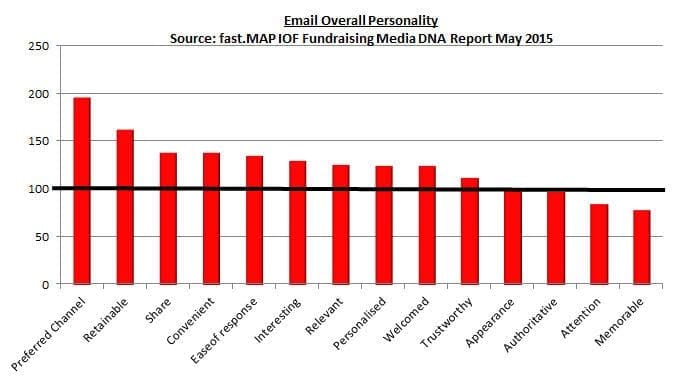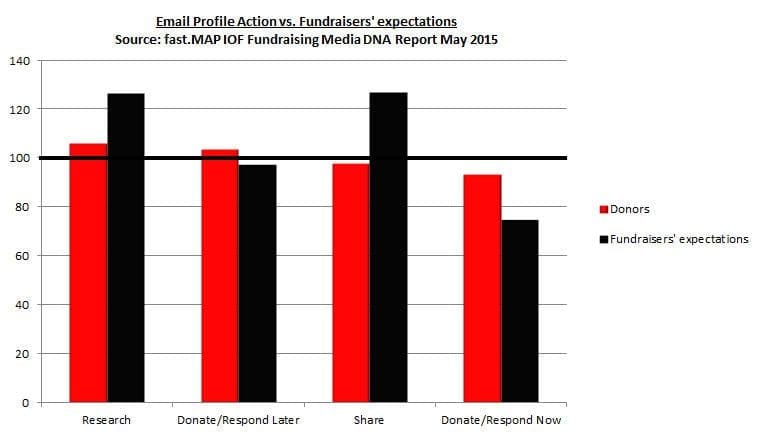Fundraising media DNA: email, the channel donors want to hear by
More people prefer to hear from charities by email than via any other medium (Preferred Index; Overall, 196), because emails are unobtrusive, easy to share or save and can be extremely attractive, interactive and personal. The channel’s drawback is that it is more likely to prompt people to do research than to donate.
In the fourth report in our detailed analysis of the Institute of Fundraising/fast.MAP Fundraising Media DNA Benchmark study, we look at how donors respond to email as a fundraising channel. You can download your copy of the Fundraising Media DNA report.
Who engages with email?
Email is donors’ most popular channel for receiving communications from charities (Preferred Index; Overall, 196).
Email is commonly viewed as a younger-audience medium; but even so fundraisers underestimate the number of 18-34s who engage with it (Engagement Index; 18-34s Estimate, 84 vs. Actual 121).
The over 55s over-index across all attributes and are more likely to take action as a result, indicating email’s viability as a contact medium for this group.
High-value donors are more likely to engage with it than low-value ones (Engagement Index; High Donors, 130 vs. Low Donors, 111) making it a valuable fundraising channel.
What is email’s personality?
All donor groups overwhelmingly prefer to hear from charities by email (Preferred Index; Overall, 196). Older groups regard emails as more “personal” than younger ones (Personalised Index; 55+, 159 vs. 18-34s 111), but even so fundraisers overestimate this personal appeal to over 55s. The only media which are rated as being more “personal” are direct mail (Personalised Index; Overall, 133) and SMS (Personalised Index; Overall, 140).
Surprisingly, the 35-54 age group finds emails more relevant than the 18-34s (Relevant Index; 35-54s, 150 vs. 18-34s 107).
Despite concern about email scams, overall people trust it (Trust Index; Overall, 111), although 35-54s display more concern (Trust Index; 35-54s, 93).
Email is not regarded as particularly attention-grabbing (Attention Index; Overall, 85) or memorable (Memorable Index; Overall, 73). This is not surprising given that people receive so many emails: 53% say they get more than three emails each day, or over 21 every week. (Source: DMA Email Tracking Report 2014).
This can be improved by using appealing subject lines and scheduling multiple emails into a campaign.
Women are more likely to hold onto an email or file it for reference (Retainable Index; Female, 212 vs. Male, 116), suggesting reminder emails would increase response and engagement.
All groups welcome them, resulting in an over-index score of 124 (Welcomed Index; Overall, 124), probably because the medium is regarded non-intrusive and friendly.
Men (Appearance Index; Male, 112) and 18-34s (Appearance Index; 18-34s, 112) rate email for its appearance, because fundraisers have become adept at utilising everything from eye-catching colour to photos, videos and links to produce interesting content. This particularly appeals to low-value donors (Interesting Index; Low Donor, 147).
Advertisement
What actions do donors take when receiving emails?
Email is easy to respond to (Ease of Response Index; Overall, 134), but it must be remembered that the most likely response is further research (Research Index; Overall, 106) or consider a donation later (Donate/Respond Later Index; Overall, 104). To make the most of these responses charities need to ensure their websites and landing pages are designed to motivate people’s conversion from expressing interest to making a donation.
Email is less effective at generating immediate results (Donate/Respond Now Index; Overall, 93), so it is advisable to use it as a way of arousing donor interest rather than generating instant donations.
While fundraisers are accurate in assessing that emails are easy to share and file for further research, they overestimate the amount of times emails are shared (Share Index; Overall Estimate, 127 vs. Actual 98).
Fundraisers acknowledge that people are unlikely to donate just because of emails, but the medium can play an important role in a multi-channel campaign which includes for example, direct mail.
What people have to say about email
“We know that email is an important part of the marketing mix for most charities. Gone are the days when charity supporters engaged only through the offline channel. Used appropriately, email marketing can deliver outstanding results – for example, Médecins Sans Frontières introduced marketing automation and a targeted segmentation strategy to improve the supporter journey and increase donations by 154%.
“The fast.MAP research highlights email as the preferred channel to hear from a charity across all demographics, regardless of the preconceived younger / older audience split (Preferred Channel index: 18-34: 185; 35-54: 217; 55+: 205). Why? Perhaps because it’s understood by supporters to be a highly cost effective channel for charities to use. Perhaps because donors can read it at their leisure, at home or on the go, and easily click through to find additional relevant content. In 2015, donors expect charities to follow them across channels and for all messages to be personal, timely and relevant – email has a vital role in that equation.
“However, despite its popularity with recipients, the report also suggests that email may not always be the best channel for driving donations, so how do we ensure this type of digital marketing continues to work hard?
“The answer will be different for each charity and its audience, though with our clients we’re continually improving email effectiveness through increased personalisation and relevancy, using rapidly developing platform capabilities to drive speed and efficiency, and strengthening engagement through the application of behavioural planning principles. Used at the right moment, email truly encompasses the mantra of targeting the right person, with the right message, at the right time.”
Dr Kiki Koutmeridou, Behavioural Scientist, Instinctiv; Nick Daggett, Partner Channel Management, Communicator.
“The difficulty with email, as with many channels, is that we as individuals respond in different ways at different times. Sitting on a train, I’ll read every word of an email, take in the details and file for acting on later. Open it in the office and it is likely to get ignored among all the other more ‘urgent’ responses needed. Getting the timing right for a campaign – when those emails are sent out – is as important as ensuring there is a compelling subject line that will grab my attention. We can see that email is not attention-grabbing (Index: 85) or memorable (Index: 73), so those few words are of vital importance.”
Scott Logie, MD, REaD Group Insight
“The research shows how important it is for fundraisers to think carefully about how individuals engage with different forms of communication and the actions they take in response. Just because something is easy for a donor to do doesn’t mean they will do it. For example, fundraisers overestimate how much donors will ‘share’ (Share Index: Estimated 127 vs. Actual 98) or ‘research further’ (Research Index: Estimated 127 vs. Actual 106) following a fundraising email.
“It’s easy to click a link in an email or forward it to a friend, but donors will only do this if it has memorable and interesting content. Asking people to do something is also key – don’t assume people will do something just because the functionality is there – make it explicit and give them a clear reason why.”
Daniel Fluskey, Head of Policy and Research, Institute of Fundraising
“The research shows email is a versatile channel which appeals broadly to all audiences. Fundraisers fail to realise that 18-34s are so willing to engage with charity in this way (Engagement Index: 18-34. Estimated 84 vs. Actual 121). This means all audiences have to be considered when devising appropriate content and creating motivating calls to action.
“Email also over-indexes for many personality attributes, including interesting content (Index: 129), being relevant to people’s likes and dislikes (125) and feeling personal (125). In fact, personalisation is an inherent feature of the channel.
“Charities which use sophisticated data collection techniques might want to examine supporter interests to send tailored messaging – though care must be taken not to cross the ‘creepy line’ where the inclusion of too much personal information becomes disturbing and detracts from the message.
“Email can complement and reinforce messages in other channels such as direct mail and DRTV. It is important to create excellent web landing pages when using email, because a likely response is for people to research further (Research Index: 106) at which point they need to be convinced to make a donation.”
David Cole, Managing Director, fast.MAP
• Read about the publication of the fast.MAP/IoF Fundraising DNA Benchmark report
• Analysis one: building trust in charities
• Analysis two: DRTV
• Analysis three: how donors respond to fundraising channels by age
Main image: charnsitr / Shutterstock.com






